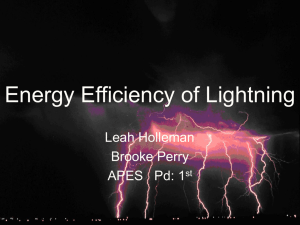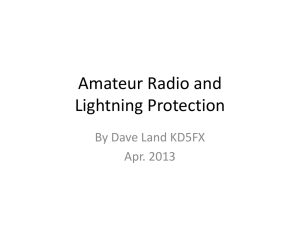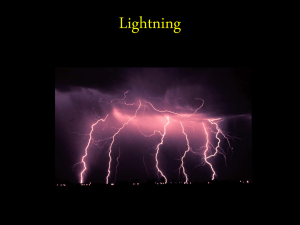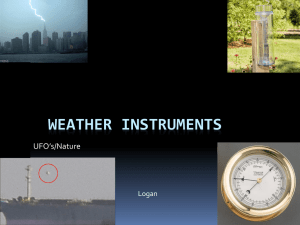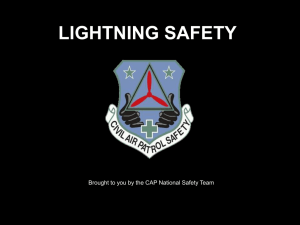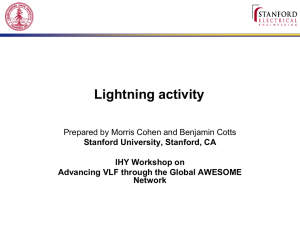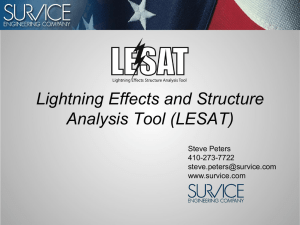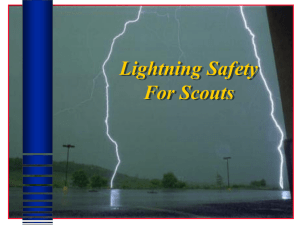The Process of Harvesting Lightning as Electrical Energy Skylar
advertisement
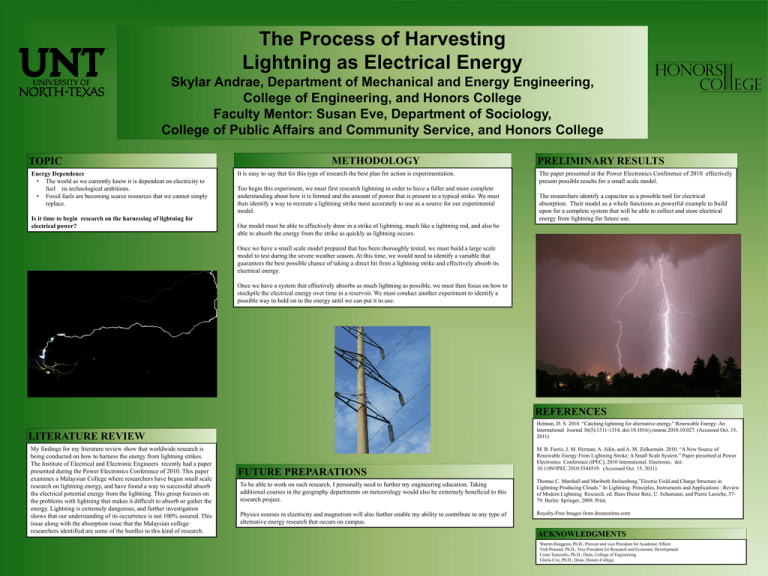
The Process of Harvesting Lightning as Electrical Energy Skylar Andrae, Department of Mechanical and Energy Engineering, College of Engineering, and Honors College Faculty Mentor: Susan Eve, Department of Sociology, College of Public Affairs and Community Service, and Honors College TOPIC Energy Dependence • The world as we currently know it is dependent on electricity to fuel its technological ambitions. • Fossil fuels are becoming scarce resources that we cannot simply replace. Is it time to begin research on the harnessing of lightning for electrical power? METHODOLOGY It is easy to say that for this type of research the best plan for action is experimentation. Too begin this experiment, we must first research lightning in order to have a fuller and more complete understanding about how it is formed and the amount of power that is present in a typical strike. We must then identify a way to recreate a lightning strike most accurately to use as a source for our experimental model. PRELIMINARY RESULTS The paper presented at the Power Electronics Conference of 2010 effectively present possible results for a small scale model. The researchers identify a capacitor as a possible tool for electrical absorption. Their model as a whole functions as powerful example to build upon for a complete system that will be able to collect and store electrical energy from lightning for future use. Our model must be able to effectively draw in a strike of lightning, much like a lightning rod, and also be able to absorb the energy from the strike as quickly as lightning occurs. Once we have a small scale model prepared that has been thoroughly tested, we must build a large scale model to test during the severe weather season. At this time, we would need to identify a variable that guarantees the best possible chance of taking a direct hit from a lightning strike and effectively absorb its electrical energy. Once we have a system that effectively absorbs as much lightning as possible, we must then focus on how to stockpile the electrical energy over time in a reservoir. We must conduct another experiment to identify a possible way to hold on to the energy until we can put it to use. REFERENCES Helman, D. S. 2010. “Catching lightning for alternative energy.“ Renewable Energy: An International Journal 36(5):1311-1314. doi:10.1016/j.renene.2010.10.027. (Accessed Oct. 15, 2011) LITERATURE REVIEW My findings for my literature review show that worldwide research is being conducted on how to harness the energy from lightning strikes. The Institute of Electrical and Electronic Engineers recently had a paper presented during the Power Electronics Conference of 2010. This paper examines a Malaysian College where researchers have begun small scale research on lightning energy, and have found a way to successful absorb the electrical potential energy from the lightning. This group focuses on the problems with lightning that makes it difficult to absorb or gather the energy. Lightning is extremely dangerous, and further investigation shows that our understanding of its occurrence is not 100% assured. This issue along with the absorption issue that the Malaysian college researchers identified are some of the hurdles to this kind of research. FUTURE PREPARATIONS To be able to work on such research, I personally need to further my engineering education. Taking additional courses in the geography departments on meteorology would also be extremely beneficial to this research project. Physics courses in electricity and magnetism will also further enable my ability to contribute to any type of alternative energy research that occurs on campus. M. B. Farriz, J. M. Herman, A. Jidin, and A. M. Zulkurnain. 2010. “A New Source of Renewable Energy From Lightning Stroke: A Small Scale System.” Paper presented at Power Electronics Conference (IPEC), 2010 International. Electronic. doi: 10.1109/IPEC.2010.5544519. (Accessed Oct. 15, 2011) Thomas C. Marshall and Maribeth Stolzenburg.”Electric Field and Charge Structure in Lightning-Producing Clouds.” In Lightning: Principles, Instruments and Applications : Review of Modern Lightning Research. ed. Hans Dieter Betz, U. Schumann, and Pierre Laroche, 5779. Berlin: Springer, 2009. Print. Royalty-Free Images from dreamstime.com ACKNOWLEDGMENTS Warren Burggren, Ph.D., Provost and vice President for Academic Affairs Vish Prasaad, Ph.D., Vice President for Research and Economic Development Costa Tsatsoulis, Ph.D., Dean, College of Engineering Gloria Cox, Ph.D., Dean, Honors College



